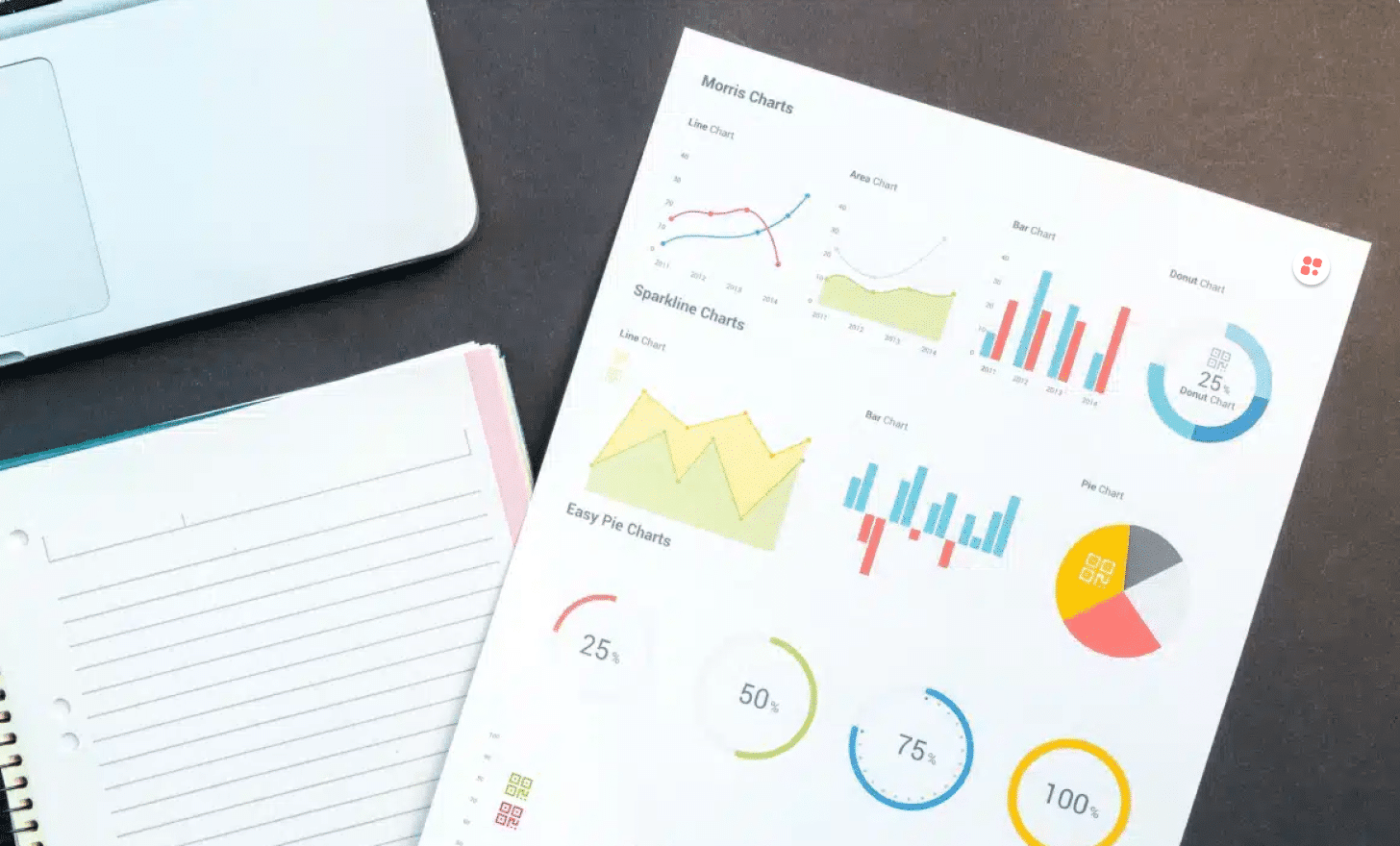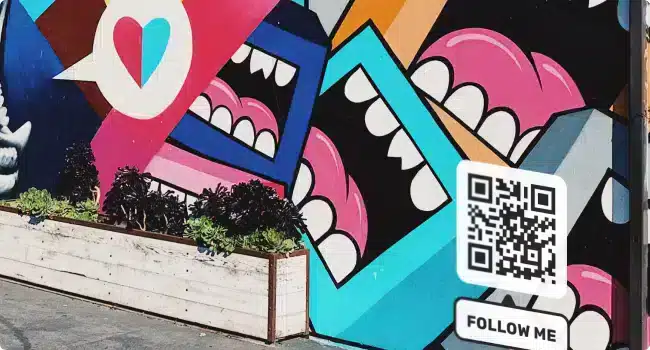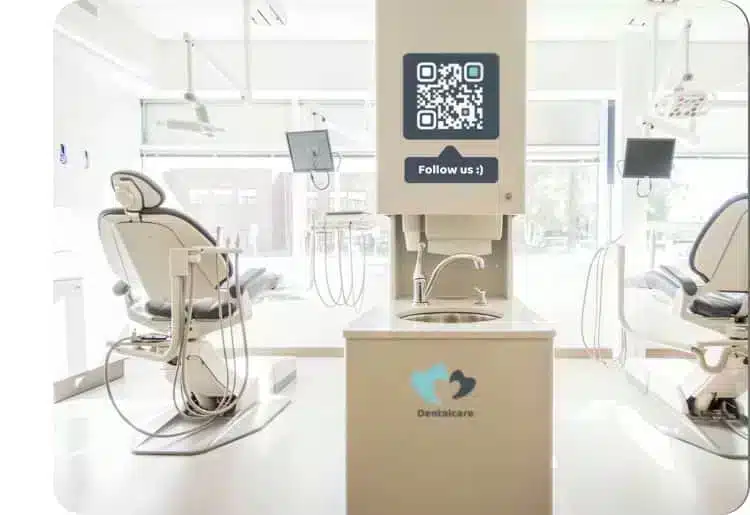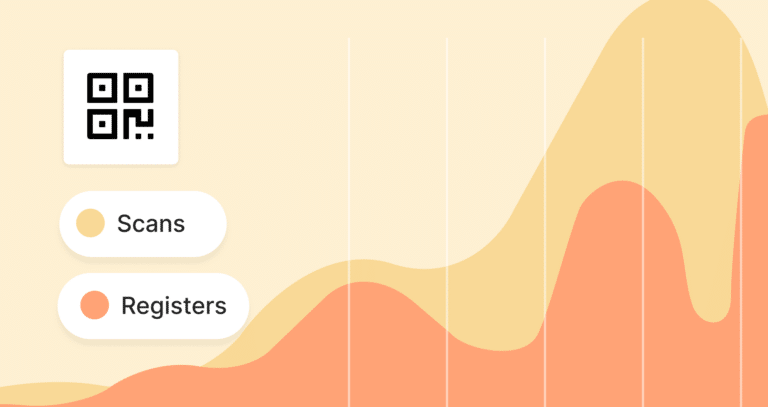What are the most popular QR code types?
According to QR Code KIT research, the most popular QR code types in the last 12 months have been the website QR code, the menu QR code, the file download QR code, the social media QR code, and the app store QR code.
QR Code Statistics 2024: Detailed Insights
- Website QR code: Frequently used by businesses to direct customers to their official websites, offering a seamless way to share URLs without manual entry.
- Usage Statistics: Over 60% of corporations have adopted website QR codes.
- Menu QR code: Predominantly utilized in the food and beverage industry, especially post-pandemic, for contactless menu access.
- Usage Statistics: 75% of restaurants have integrated menu QR codes, leading to a 30% reduction in menu printing costs and a 40% boost in customer engagement.
- File download QR code: Ideal for providing quick access to downloadable resources like PDFs, brochures, and manuals.
- Usage Statistics: Corporate and SMB adoption rate stands at 50%, with a notable 25% year-on-year increase in usage for sharing digital content.
- Social Media QR code: Helps in growing social media presence by linking directly to profiles or specific posts.
- Usage Statistics: Used by 70% of brands for enhancing social media engagement, contributing to a 35% rise in follower growth.
- App Store QR code: Simplifies the process of downloading apps by redirecting users to the respective app stores.
- Usage Statistics: Employed by 65% of companies with mobile apps, resulting in a 45% increase in app downloads.
Let’s explore these statistics further and understand how corporations and SMBs utilize these QR codes worldwide to enhance their operations and customer interactions.
QR codes are still on the rise
In 2024, QR codes continue to see a significant surge in usage across various sectors. These versatile black and white squares can store diverse information, ranging from website URLs to contact details, account information, and more.
QR Code Statistics 2024: Rising usage and trends
- Adoption Rate: The adoption of QR codes has seen consistent growth, with a significant number of smartphone users interacting with QR codes regularly.
- Information Storage: QR codes are now used to store more complex data, including payment information, event tickets, and loyalty program details, making them indispensable in everyday transactions.
- Traditional Methods Replacement: With the rise of QR codes, traditional data-sharing methods like business cards and paper documents are seeing a decline. Many businesses have transitioned to digital business cards with QR codes.
- Consumer Applications: The use of QR codes in consumer applications is expanding rapidly. They are now commonly found in marketing campaigns, product packaging, and customer service touchpoints, enhancing user engagement and data collection.
- Bridging the Gap: QR codes serve as a seamless link between the digital and physical worlds. They allow users to effortlessly access online content from physical media, enhancing the user experience and driving higher interaction rates.
As QR codes become more integrated into daily life, they represent an intuitive and efficient method for sharing information and facilitating transactions, bridging the gap between the online and offline worlds effortlessly.
QR code creation increased by 43% in 2023
Insights from various sources suggest that QR code creation, which in 2022 skyrocketed by 283% over 2021, has increased by an additional 43% in the past year. Globally, QR code scans surged significantly during the same period.

Key trends in QR code usage
- Increased Creation: The substantial rise in QR code creation highlights the growing adoption of this technology across multiple industries.
- Global Adoption: The increase in QR code scans indicates that more people globally are using QR codes in their daily lives, reflecting a shift towards more tech-savvy and mobile-friendly solutions.
- Business and Consumer Popularity: QR codes are becoming increasingly popular among businesses, marketers, and consumers alike. They are utilized for various purposes, including marketing, payments, product registration, and customer engagement.
Benefits of QR code usage
- Streamlined Processes: QR codes help expedite key processes in the customer journey, such as payment handling and product registration.
- Enhanced Personalization: By leveraging QR codes, companies can offer a more personalized experience to their customers. This includes customized marketing campaigns, tailored offers, and more efficient service delivery.
- Efficiency and Convenience: QR codes provide a quick and convenient way to access information, make payments, and interact with products and services. This convenience drives higher engagement and satisfaction among users.
As QR codes continue to gain popularity, their role in enhancing business operations and customer experiences becomes more evident. The increase in QR code creation and usage is a testament to their effectiveness and versatility in the modern digital landscape.
The most popular QR code types top five

1. Website QR code
The website QR code is the most popular type of QR code, with 49% of all codes created over the last 12 months dedicated to this use. This means that around half of the QR codes out there are for websites.
The website QR code is the basic, most flexible type of QR. It connects visitors to any URL, from a web page to a social media account, a Google Drive folder, or a file stored online.
This is also the simplest type of QR code to make: just paste a URL in our editor and save the QR. It works as a link shortener, too. Every time a dynamic QR code is created, a corresponding unique, customizable short URL is also generated.
Website QR codes are essential for businesses looking to streamline their digital presence, enhance user engagement, and provide instant access to their online resources.
2. Menu QR code
9% of QR codes created globally are menu QR codes. You likely have scanned some of them yourself at your favorite bars and restaurants.
Digital menus became ubiquitous when the pandemic hit, but even if paper menus have been reintroduced, digital menus remain commonly available at most food venues, hotels, nail bars, etc.
Several companies in retail and manufacturing use them for product catalogs too! This trend reflects the broader adoption of QR codes in various customer-facing applications, enhancing convenience and improving user experience.

3. File download QR code
6% of all QR codes enable people to download a file directly. Virtually any type of file can be made available to users through this code: PDFs, word documents, spreadsheets, images, short videos, MP3s, zip archives, etc.
The file download QR code is used across all industries for many different purposes, from portfolio sharing to digital signing, including all the use cases when companies or people cannot upload sensitive documents or private content to the broader Internet.
This type of QR code is invaluable for businesses aiming to distribute digital content efficiently and securely, facilitating easy access to important documents.
4. Social media QR code
Close behind the file download QR code ranks the social media QR code, with almost 6% of QRs generated.
The social media QR code is the godfather of all link-in-bio tools: a mobile-optimized space to conveniently list all your social accounts and pages, making them available through a single QR – or short link.
This type of QR is particularly popular in the US: American users created 43% of all social media QR codes last year. Social media QR codes are instrumental for influencers, brands, and individuals looking to boost their online presence and engage with their audience more effectively.

5. App store QR code
4% of QR codes created over the last 12 months were app store QR codes used to make people download mobile applications.
With the number of app downloads worldwide steadily increasing by around 20% each year, it comes as no surprise that the usage of this type of QR code is quickly growing, too.
The best thing about the app store QR code is that it detects the operating system of the scanning device (Android or iOS) and automatically redirects visitors to the appropriate app store to download the application.
The app store QR code is a brands’ favorite, and like the social media one, is very popular in the US, with 30% of all app store QRs created. This type of QR code is crucial for app developers and marketers aiming to streamline the download process and increase app installations.
Other types of QR codes available in QR Code KIT
Beyond the top five most popular QR codes, QR Code KIT offers a variety of other QR code types that cater to diverse needs and applications. Each type is designed to provide specific functionalities and benefits, making it easier for businesses and individuals to connect and engage with their audience. Here’s an overview of the additional QR code types available:
Landing page QR code
The Landing Page QR code allows you to build optimized mobile or rich content landing pages easily without coding. This type of QR code is perfect for marketing campaigns where you want to deliver a specific message or collect user information seamlessly.
- Usage Example: Marketers can use Landing Page QR codes in their print advertisements to direct users to a campaign-specific landing page with promotional offers and detailed information.
Digital business card QR code
The Digital Business Card QR code enables users to add contact information directly to their phone’s contacts with a single scan. This modern approach to business cards ensures that your contact details are always available and easily shareable.
- Usage Example: Professionals can print Digital Business Card QR codes on their traditional business cards to provide a quick and efficient way for contacts to save their information.
Check-In form QR code
The Check-In Form QR code is ideal for digitally registering people and managing access. This type of QR code is commonly used at events, offices, or any location where tracking attendance is necessary.
- Usage Example: Event organizers can place Check-In Form QR codes at the entrance to streamline the registration process and gather attendee information.
Email QR code
The Email QR code facilitates receiving messages from leads and customers in your inbox. When scanned, it opens the user’s email client with a pre-filled recipient address and subject line, making it easier for users to contact you.
- Usage Example: Customer service departments can use Email QR codes in their marketing materials to encourage customers to send inquiries or feedback directly.
WhatsApp QR code
The WhatsApp QR code automatically opens a WhatsApp conversation with a scan. This type of QR code is particularly useful for businesses that use WhatsApp for customer support or communication.
- Usage Example: E-commerce stores can include WhatsApp QR codes on their websites or product packaging to provide direct customer support through WhatsApp.
Google Maps QR code
The Google Maps QR code provides directions and locations easily through a scan. It’s perfect for businesses that want to guide customers to their physical location.
- Usage Example: Retail stores and restaurants can display Google Maps QR codes on their flyers and business cards to help customers find their location effortlessly.
Google Reviews QR code
The Google Reviews QR code helps businesses collect valuable feedback from visitors and customers. By scanning the code, users are directed to the business’s Google review page.
- Usage Example: Restaurants and service providers can place Google Reviews QR codes at their premises to encourage satisfied customers to leave positive reviews.
YouTube QR code
The YouTube QR code connects users to videos or entire channels. This is a great way to promote video content and increase viewership.
- Usage Example: Content creators can use YouTube QR codes on their promotional materials to drive traffic to their latest videos or channel.
PayPal QR code
The PayPal QR code enables payments and donations with a simple scan. It’s an efficient way to facilitate transactions without the need for entering lengthy payment details.
- Usage Example: Nonprofits and street vendors can use PayPal QR codes to accept donations or payments quickly and securely.
Deep Link QR code
The Deep Link QR code connects visitors to specific pages within your mobile app. This is useful for directing users to a particular section or feature within the app.
- Usage Example: App developers can use Deep Link QR codes in their marketing campaigns to guide users to new features or promotions within their app.
Multilingual QR code
The Multilingual QR code automatically directs visitors to the version of your site in their language. This ensures that users have a seamless experience in their preferred language.
- Usage Example: Global businesses can use Multilingual QR codes on their marketing materials to cater to a diverse audience.
Coupon QR code
The Coupon QR code helps distribute discounts and vouchers effortlessly. Users can scan the code to receive a discount or special offer.
- Usage Example: Retailers can use Coupon QR codes in their advertising campaigns to attract customers with exclusive discounts.
Lead generation QR code
The Lead Generation QR code collects contact information and provides rewards to users. This type of QR code is perfect for building your customer database and offering incentives.
- Usage Example: Businesses can use Lead Generation QR codes at trade shows to collect contact details in exchange for a free gift or discount.
How to choose the best QR code generator?
All five top QR code types are recommended to drive traffic to your digital content, collect leads and followers, boost conversions, generate footfall to physical stores, increase online and offline purchases, and much more.
Picking the right one to fit your needs obviously depends on your campaign’s goals. But before that, you should know the eight golden rules for choosing the right QR code generator since too many are available.

Eight golden rules for choosing the right QR code generator
Dynamic QR codes
Dynamic QR codes offer significant advantages over static ones. They allow you to change the destination URL without altering the QR code itself. This flexibility is essential for long-term campaigns where the destination link might need to be updated. With dynamic QR codes, you can also track and analyze the performance, helping you understand user engagement and optimize your marketing strategies.
- Usage Example: A retail store can use a dynamic QR code in its seasonal marketing materials. If the promotion changes, the store can update the URL linked to the QR code without having to reprint new materials.
Multiple QR code types
A robust QR code generator should offer a wide variety of QR code types to meet different campaign needs. From website URLs and digital business cards to file downloads and social media links, having multiple options ensures that you can create the right QR code for any situation.
- Usage Example: A company launching a multi-channel marketing campaign can use different types of QR codes for different platforms, such as a YouTube QR code for video content and a PayPal QR code for donations.
Customization options
Customization is key to making your QR codes stand out. A good QR code generator should allow you to customize your codes with colors, logos, images, and more. Customization helps in brand recognition and makes your QR codes more appealing to scan.
- Usage Example: A brand can design its QR codes with its logo and corporate colors, ensuring that the codes are visually appealing and easily recognizable as part of its brand identity.
Various download formats
Different download formats for the QR codes should be available (from PNG to PDF, EPS, etc.). This ensures you can use your QR codes across different media and platforms without compromising on quality. High-quality vector formats are especially important for printing.
- Usage Example: A marketing agency can download QR codes in EPS format for high-quality print materials and in PNG format for use on digital platforms.
QR code tracking and analytics
Choose a QR code generator with robust tracking capabilities and analytics. This feature allows you to measure the success of your campaigns by providing data on how often and where your QR codes are scanned. Insights gained from analytics can help you refine your marketing strategies and improve engagement.
- Usage Example: An event organizer can track how many people scanned the event QR code, where they scanned it from, and which promotional channels were most effective.
Mobile landing page builder
An intuitive mobile landing page builder is a must-have. It ensures that users have a seamless experience when they scan your QR code, improving engagement and conversion rates. Mobile-optimized landing pages are crucial as a majority of users access content via their smartphones.
- Usage Example: A restaurant can use a mobile landing page builder to create an attractive, easy-to-navigate digital menu that enhances the dining experience.
Security and data protection
Safety and data protection are paramount. You need a QR code generator that is reliable and secure, protecting both your data and that of your users. Ensure that the platform complies with data protection regulations and offers secure ways to handle sensitive information.
- Usage Example: A healthcare provider can use secure QR codes to share confidential patient information, ensuring that the data is protected and only accessible to authorized personnel.
QR management features
Great QR code platforms provide comprehensive QR management features and different subscription plans suited for various QR needs. This includes organizing, editing, and tracking your QR codes efficiently. The ability to manage multiple QR codes from a single dashboard can save time and streamline operations.
- Usage Example: A large corporation can manage hundreds of QR codes used in different departments and campaigns from a single interface, ensuring consistency and easy access to analytics.
Why choose QR Code KIT?
QR Code KIT checks all these boxes and more. It’s not by chance that we’re still leading the market after twelve years since we launched our platform in 2009.
Since you’re around here, why don’t you give it a try? We have a 14-day trial of our Professional plan available. No credit card required, no hidden fees.
Trust hundreds of actual customers who gave us five stars on Trustpilot, and register for free today!

Understanding QR code statistics: A comprehensive overview
In the ever-evolving digital landscape, QR code statistics provide invaluable insights into the adoption and effectiveness of this versatile technology. Analyzing these statistics helps businesses and marketers understand trends, user behaviors, and the overall impact of QR codes on various industries. Here’s an in-depth look at the current QR code statistics and what they mean for your business.
Growth in QR code adoption
QR code statistics reveal a significant increase in the creation and usage of QR codes over the past few years. According to recent data, the adoption of QR codes has surged, driven by the need for contactless solutions and the increasing familiarity of consumers with scanning QR codes using their smartphones. This rise is particularly notable in sectors such as retail, hospitality, and healthcare, where QR codes are used to streamline processes and enhance customer experiences.
QR code usage across industries
Different industries leverage QR codes in unique ways, and QR code statistics highlight the diverse applications. In the retail sector, QR codes are commonly used for product information, promotions, and contactless payments. In the hospitality industry, they facilitate digital menus and hotel check-ins. Healthcare providers use QR codes for patient information and appointment scheduling. These varied uses underline the flexibility and utility of QR codes across multiple domains.
Consumer interaction with QR codes
Understanding how consumers interact with QR codes is crucial for optimizing their use. QR code statistics indicate that a large percentage of consumers have scanned a QR code at least once, with many doing so regularly. The ease of use and convenience of QR codes make them a popular choice for accessing information quickly. Marketers can capitalize on this trend by integrating QR codes into their campaigns to drive engagement and conversions.
Impact on marketing and sales
The impact of QR codes on marketing and sales is significant. QR code statistics show that campaigns incorporating QR codes often see higher engagement rates compared to those that do not. This is because QR codes simplify the process of accessing promotional content, making it more likely that consumers will take the desired action. For example, a QR code in a print advertisement can lead directly to a landing page, increasing the likelihood of conversion.
Future trends in QR code statistics
Looking ahead, QR code statistics suggest continued growth and innovation. Emerging trends include the integration of QR codes with augmented reality (AR) and virtual reality (VR), which can create more interactive and immersive experiences. Additionally, advancements in QR code customization and tracking will provide businesses with even more powerful tools for engaging their audiences and measuring the success of their campaigns.
Leveraging QR code statistics for your business
To make the most of QR codes, businesses should pay close attention to QR codes statistics and trends. By understanding how QR codes are being used and what consumers expect, businesses can design more effective QR code campaigns. This involves not only creating attractive and functional QR codes but also analyzing scan data to refine strategies and improve outcomes.
In conclusion, QR code statistics offer a wealth of information that can help businesses optimize their use of QR codes. From understanding adoption rates and consumer behaviors to exploring new trends and technologies, these statistics provide a roadmap for leveraging QR codes effectively. As the digital landscape continues to evolve, staying informed about the latest QR codes statistics will be key to maintaining a competitive edge and driving success in your marketing efforts.

QR code best practices
To maximize the effectiveness of QR codes in your marketing and operational strategies, it’s essential to follow best practices. Adhering to these guidelines ensures that your QR codes are user-friendly, functional, and engaging.
Design and customization
- Keep it simple: While customization is important, ensure that the QR code remains scannable. Avoid overly complex designs that might interfere with readability.
- Branding elements: Incorporate your logo and brand colors to make the QR code recognizable and aligned with your brand identity.
- Clear instructions: Provide a brief description or call-to-action near the QR code to guide users on what to expect when they scan it.
Placement and visibility
- Strategic placement: Place QR codes in locations where they are easily visible and accessible. Ensure that they are within reach and can be scanned comfortably.
- Size matters: Ensure the QR code is large enough to be scanned from a reasonable distance. A minimum size of 1 x 1 inch is generally recommended for print materials.
- High contrast: Use high-contrast colors to ensure the QR code stands out against its background, making it easier to scan.
Testing and functionality
- Pre-Testing: Test the QR code with multiple devices and QR code scanning apps to ensure it works correctly and leads to the intended content.
- Dynamic QR codes: Utilize dynamic QR codes that allow you to change the linked content without altering the QR code itself. This provides flexibility and helps avoid printing new materials for every update.
- Error correction: Choose QR codes with high error correction levels to ensure they remain scannable even if part of the code is damaged or obscured.
Security and compliance
- Secure URLs: Ensure that the URLs linked to your QR codes are secure (using HTTPS) to protect user data and build trust.
- Data privacy: Comply with data protection regulations, especially if the QR code links to forms collecting personal information.
- Regular Updates: Regularly update the content linked to your QR codes to ensure it remains relevant and accurate.
Benefits of using QR codes in different industries
QR codes offer numerous benefits across various industries. Understanding these advantages can help businesses leverage QR codes more effectively.
Retail
- Product information: QR codes can link to detailed product descriptions, reviews, and user guides, enhancing the shopping experience.
- Promotions and discounts: Retailers can use QR codes to distribute coupons and special offers, driving sales and customer loyalty.
- Inventory management: QR codes streamline inventory tracking and management, improving efficiency and accuracy.
Hospitality
- Contactless menus: Restaurants and hotels can offer digital menus, reducing the need for physical copies and enhancing hygiene.
- Guest services: QR codes can link to hotel services, local attractions, and amenities, providing guests with convenient access to information.
- Reservations and Check-Ins: QR codes simplify the reservation and check-in process, improving the overall guest experience.
Healthcare
- Patient information: QR codes can provide quick access to patient records and medical histories, facilitating better healthcare delivery.
- Appointment scheduling: Patients can scan QR codes to schedule appointments or check in, reducing wait times and administrative burden.
- Medication information: QR codes on medication packaging can link to dosage instructions, potential side effects, and other crucial information.

Events and entertainment
- Ticketing: QR codes simplify ticketing by enabling digital tickets that can be scanned at entry points.
- Event information: Attendees can access event schedules, speaker bios, and venue maps through QR codes, enhancing their experience.
- Engagement: QR codes can link to social media pages, contests, and other interactive content, boosting engagement and participation.
Emerging technologies and QR codes
As technology continues to advance, QR codes are evolving with new features and capabilities. Exploring these emerging technologies can help businesses stay ahead of the curve.
Augmented Reality (AR)
- Interactive experiences: QR codes can trigger AR experiences, allowing users to interact with products or services in a virtual environment.
- Enhanced marketing: Brands can create immersive marketing campaigns that engage users in new and exciting ways through AR-enabled QR codes.
Internet of Things (IoT)
- Smart devices: QR codes can connect users to smart devices, enabling seamless control and interaction with IoT-enabled products.
- Data collection: QR codes on IoT devices can link to data dashboards, providing real-time information and analytics.
Blockchain and cryptocurrency
- Secure transactions: QR codes facilitate secure cryptocurrency transactions, making it easier for users to send and receive digital currency.
- Verification and traceability: Blockchain-based QR codes can verify the authenticity of products and track their journey through the supply chain.
Artificial Intelligence (AI)
- Personalized content: AI can analyze QR code scan data to deliver personalized content and recommendations to users.
- Enhanced analytics: AI-powered analytics provide deeper insights into QR code performance, helping businesses optimize their campaigns.
Understanding QR code statistics: A comprehensive overview
In the ever-evolving digital landscape, QR code statistics provide invaluable insights into the adoption and effectiveness of this versatile technology. Analyzing these statistics helps businesses and marketers understand trends, user behaviors, and the overall impact of QR codes on various industries. Here’s an in-depth look at the current QR code statistics and what they mean for your business.
Growth in QR code adoption
QR code statistics reveal a significant increase in the creation and usage of QR codes over the past few years. According to recent data, the adoption of QR codes has surged, driven by the need for contactless solutions and the increasing familiarity of consumers with scanning QR codes using their smartphones. This rise is particularly notable in sectors such as retail, hospitality, and healthcare, where QR codes are used to streamline processes and enhance customer experiences.
QR code usage across industries
Different industries leverage QR codes in unique ways, and QR code statistics highlight the diverse applications. In the retail sector, QR codes are commonly used for product information, promotions, and contactless payments. In the hospitality industry, they facilitate digital menus and hotel check-ins. Healthcare providers use QR codes for patient information and appointment scheduling. These varied uses underline the flexibility and utility of QR codes across multiple domains.
Consumer interaction with QR codes
Understanding how consumers interact with QR codes is crucial for optimizing their use. QR code statistics indicate that a large percentage of consumers have scanned a QR code at least once, with many doing so regularly. The ease of use and convenience of QR codes make them a popular choice for accessing information quickly. Marketers can capitalize on this trend by integrating QR codes into their campaigns to drive engagement and conversions.
Impact on marketing and sales
The impact of QR codes on marketing and sales is significant. QR code statistics show that campaigns incorporating QR codes often see higher engagement rates compared to those that do not. This is because QR codes simplify the process of accessing promotional content, making it more likely that consumers will take the desired action. For example, a QR code in a print advertisement can lead directly to a landing page, increasing the likelihood of conversion.
Future trends in QR code statistics
Looking ahead, QR code statistics suggest continued growth and innovation. Emerging trends include the integration of QR codes with augmented reality (AR) and virtual reality (VR), which can create more interactive and immersive experiences. Additionally, advancements in QR code customization and tracking will provide businesses with even more powerful tools for engaging their audiences and measuring the success of their campaigns.
Leveraging QR code statistics for your business
To make the most of QR codes, businesses should pay close attention to QR code statistics and trends. By understanding how QR codes are being used and what consumers expect, businesses can design more effective QR code campaigns. This involves not only creating attractive and functional QR codes but also analyzing scan data to refine strategies and improve outcomes.
In conclusion, QR code statistics offer a wealth of information that can help businesses optimize their use of QR codes. From understanding adoption rates and consumer behaviors to exploring new trends and technologies, these statistics provide a roadmap for leveraging QR codes effectively. As the digital landscape continues to evolve, staying informed about the latest QR code statistics will be key to maintaining a competitive edge and driving success in your marketing efforts.


